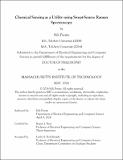Chemical Sensing as a Utility using Swept-Source Raman Spectroscopy
Author(s)
Persits, Nili
DownloadThesis PDF (9.373Mb)
Advisor
Ram, Rajeev J.
Terms of use
Metadata
Show full item recordAbstract
The integration of chemical sensing into everyday life is a decades-old dream that has so far failed to come to fruition. Many sensor technologies have been proposed and developed, but few can claim to be non-destructive, reagent-free, and suitable for multiple applications while also enabling significant scale-up and remaining cost-effective.
This thesis proposes a utility service model for chemical sensing using Swept Source-Raman Spectroscopy (SSRS) that addresses these challenges. First, we introduce the SSRS fiber-probe that allows to measure Raman spectra with a single-point detector and only a few milliwatts of tunable laser excitation. We validate the probe design by monitoring nitrate fertilizer in a hydroponic setup, in environmental water samples, and in growing plants with sensitivity and resolution which are equivalent to benchtop systems. We further demonstrate the scaling up of SSRS into a sensor network by leveraging readily-available data communication optical fiber infrastructure. We showcase a 16-sensor network that uses the laser as a shared resource and develop an engineering-based cost model that supports the scaling up of this network to dozens of sensors deployed over kilometers. Lastly, we monitor metabolites in a therapeutic-producing cell culture, and use linear regression models and a-priori information of our samples to reduce the spectral acquisition time, making this sensor architecture competitive in both performance and cost to existing solutions. These findings represent significant progress towards achieving ubiquitous chemical sensing and facilitating the integration of chemical sensors into everyday life.
Date issued
2024-05Department
Massachusetts Institute of Technology. Department of Electrical Engineering and Computer SciencePublisher
Massachusetts Institute of Technology